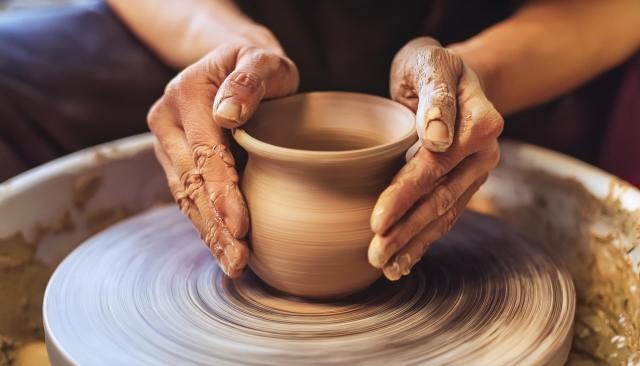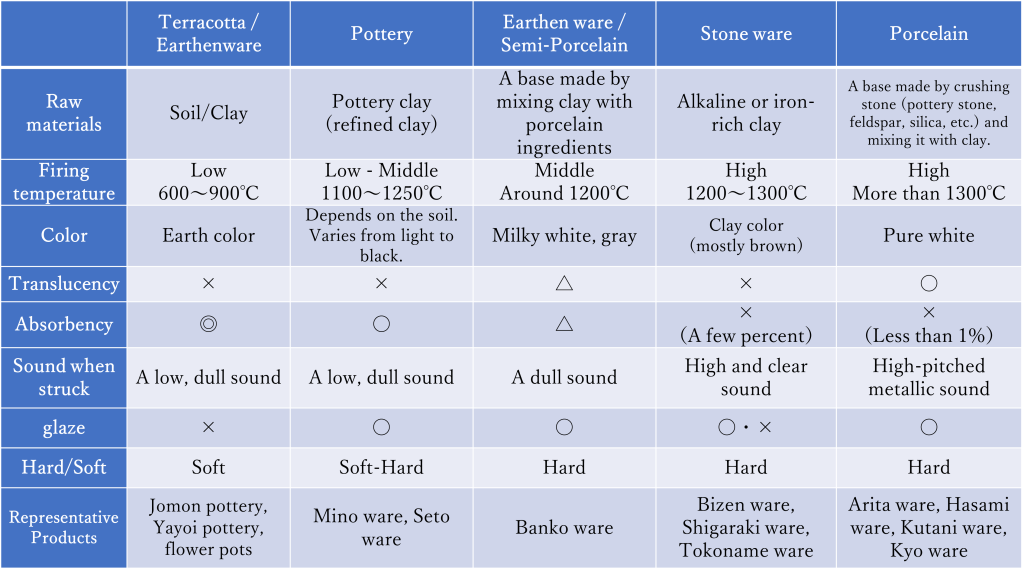News
2023.09.28
Columns
What is the Difference between Pottery, Porcelain and Ceramics?

Pottery, porcelain, ceramics… do you know the differences between them? Some people may refer to all tableware as pottery or porcelain, but in fact, each has its own unique characteristics. In this column, we will introduce the differences between these types of Ceramics.
Table of Contents
1. What is Ceramics?
2. Differences between the Five Types of Ceramics
3. What is “Tojiki”?
4. Conclusion
What are Ceramics?
First of all, “ceramics” is a general term for things made by forming clay and firing it. We call it in Japanese “yakimono” (“yaki” = firing. “mono” = things) . The history of ceramics is quite long, and Jomon pottery made in the Jomon period is also a type of ceramics. In modern times, ceramics are sometimes called by place names such as Seto ware and Mino ware, but there are also names based on differences in materials and properties, such as pottery and porcelain. Most of the ceramics currently produced in Japan fall into one of the following categories: pottery, semi-porcelain (or also called earthenware), stoneware, or porcelain. Semi-porcelain and stoneware are often confused, but they are technically different, so we will introduce them separately here.
Differences between the Five Types of Ceramics
The table below summarizes the differences between terracotta, pottery, semi-porcelain, stoneware and porcelain.

Terracotta / Earthenware
Terracotta / Earthenware, is made by mixing earth or clay with water and firing it at a low temperature without using glaze. It does not require special facilities such as kilns and is usually fired in an open-air firing. It is characterized by being porous and absorbent. Earthenware, which has the longest history and is still produced today, includes unglazed flowerpots and bricks.
Pottery
Pottery is made from clay and is characterized by its soft firing and earthy texture and warmth. Because pottery is absorbent, if it is left dirty after use, dirt will be absorbed. It is necessary to wash it immediately after use and dry it well.
Semi-porcelain (Earthenware)
Semi-porcelain is made by mixing clay with stone powder, which is a material for porcelain. Since it contains the raw material for porcelain, it has a milky white color. Its properties are between pottery and porcelain, and it has some translucency and some water permeability. When you hit it, it does not resonate, and although it does not reach the level of pottery, it does make a dull sound.
Stoneware
Stoneware is made by firing clay at very high temperatures. Its color is the same as the clay, and is usually brown or dark brown. Since it is made only of clay, it has no translucency at all. Because it is fired at high temperatures, it becomes covered in a glassy substance, and as a result, it has almost no water permeability.
Porcelain
Porcelain is characterized by a hard and smooth texture like glass and a pure white color. Porcelain is not absorbent, so it does not need to be dried well like pottery, and it is easy to handle as home tableware. Also, since the roots of porcelain are in China, porcelain is sometimes called “china”.
What is “Tojiki”?
In Japan, pottery (“touki”) and porcelain (“jiki”) are sometimes collectively called “tojiki” (陶磁器 = ceramics). For example, in Seto City, Aichi Prefecture, famous for Seto ware, and Mino City, Gifu Prefecture, famous for Mino ware, both pottery and porcelain are actively produced depending on the purpose, as both clay and pottery stone can be mined. In some areas, the main product has shifted from pottery to porcelain over time.
As you can see, even though pottery and porcelain are different types, it can be more convenient to flexibly refer to them all as “tojiki” ceramics.
Conclusion
Have you understood the differences between 5 types of ceramics? The differences in the materials used mean that the finished ceramics have different colors and properties. By paying attention to the differences in the ceramics you use and see every day, you can enjoy familiar ceramics from a different perspective.
Imoto Sangyo handles various types of ceramics, kitchenware, and daily necessities.
For more information, please see the “Goods & Cases” page.
Category
Archive

